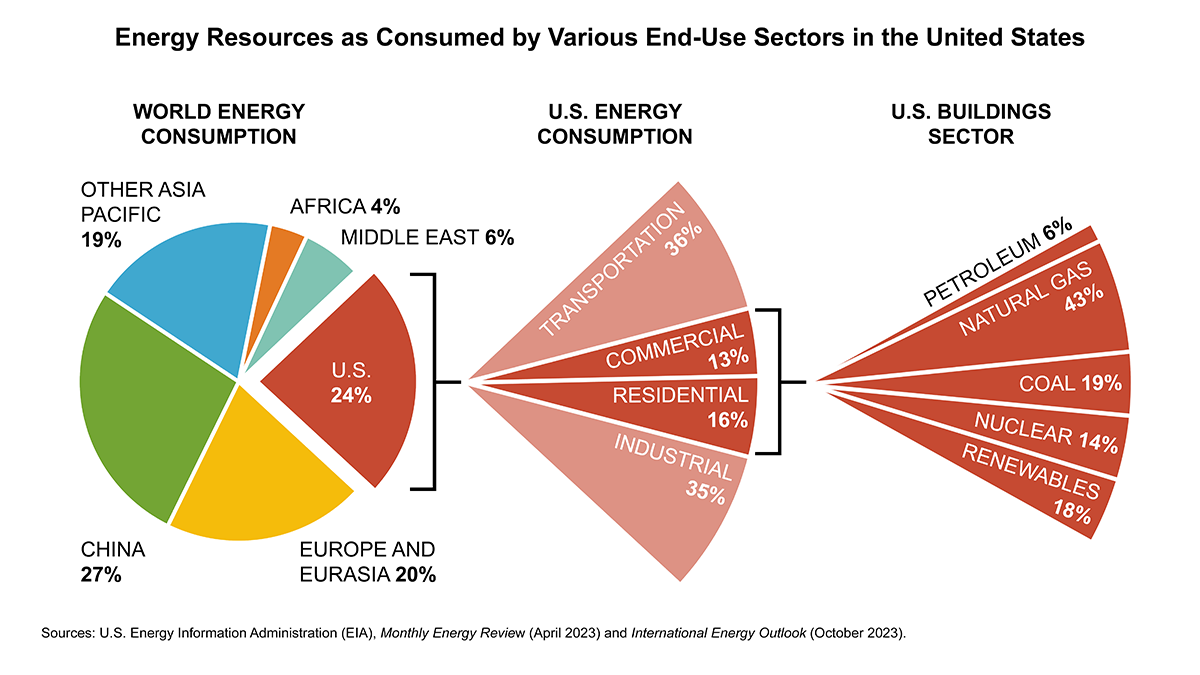Occasionally, I hear contrasting—at times, even incompatible—notions about the United State's energy consumption. Word-of-mouth can allow talking points to take on lives of their own and data trends change over time. What does current data offer in terms of the U.S. energy sector?
U.S. and World Energy Consumption
There is little misconception about the broader global context. The United States is one of the largest consumers of energy in the world. According to 2022 data from the U.S Energy Information Administration (an independent agency established by the U.S. Congress in 1977 and operating under the U.S. Department of Energy), the U.S accounts for about a quarter of global energy consumption (despite having less than 5 percent of the world's population).
U.S. Energy Use by Sector
EIA data often segments U.S. energy consumption by four broad "end use sectors": transportation, commercial use, residential use, and industrial use. On this basis, the commercial and residential sectors generally account for all building (and site) energy consumption. In 2022, the U.S. commercial sector accounted for 13 percent of the country's energy consumption; while the residential sector accounted for 16 percent. These proportions have actually declined in recent years, indicating that the building sector is generally becoming more energy-efficient.
U.S. Buildings Sector
A deeper dive in to commercial and residential sector energy data reveals additional insights. Although the U.S. buildings sector continues to primarily rely on fossil fuel-based energy resources (i.e., natural gas, coal, and petroleum), nuclear energy consistently accounts for about 14 percent of energy consumption. Moreover, the proportion of consumption attributed to renewable energy (which entails both utility-scale and localized resources) has doubled. Renewable energy now provides more energy to buildings in the U.S than nuclear utility sources.
2022 EIA data also reveal that the U.S. electric power sector continues to exhibit significant transmission losses. Of the 37.8 quadrillion Btu attributed to the electric power sector, 24.4 quadrillion Btu (65 percent) were lost prior to delivery to ultimate consumers. (These sector-based system losses were taken into consideration regarding the information cited above.)
Among the proportion of energy resources consumed by the U.S. buildings sector, it is also worth noting that over twice as much of the country's total renewable electricity production was directly delivered to the residential sector compared to the commercial sector.
Regarding fossil-fuel energy resources delivered to the country's building sector, the past decade has seen an approximate 20 percent proportional increase in natural gas resource consumption as coal has dropped by over 40 percent.
In summary, the United States continues to consume a disproportionately large amount of energy compared to other countries and regions across the globe. However, the proportion of energy consumption required by buildings in the U.S. continues to slowly decrease. Within the country's building sector, natural gas and renewables continue to increase in proportion as nuclear and petroleum sources appear to have plateaued, and coal continues to decrease. Transition is underway as our buildings progressively use less energy and cleaner energy. The challenge remains to be the rate at which the transition occurs.
|
Figure: Energy resources as consumed by various end-use sectors in the United States, 2022. |


